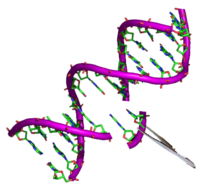
Photo from wikipedia
Recent phase I/II adeno-associated viral vector-mediated gene therapy clinical trials have reported remarkable success in ameliorating disease phenotype in hemophilia A and B. These trials, which highlight the challenges overcome… Click to show full abstract
Recent phase I/II adeno-associated viral vector-mediated gene therapy clinical trials have reported remarkable success in ameliorating disease phenotype in hemophilia A and B. These trials, which highlight the challenges overcome through decades of preclinical and first in human clinical studies, have generated considerable excitement for patients and caregivers alike. Optimization of vector and transgene expression has significantly improved the ability to achieve therapeutic factor levels in these subjects. Long-term follow-up studies will guide standardization of the approach with respect to the combination of serotype, promoter, dose, and manufacturing processes and inform safety for inclusion of young patients. Certain limitations preclude universal applicability of gene therapy, including transient liver transaminase elevations due to the immune responses to vector capsids or as yet undefined mechanisms, underlying liver disease from iatrogenic viral hepatitis, and neutralizing antibodies to clotting factors. Integrating vectors show promising preclinical results, but manufacturing and safety concerns still remain. The prospect of gene editing for correction of the underlying mutation is on the horizon with considerable potential. Herein, we review the advances and limitations that have resulted in these recent successful clinical trials and outline avenues that will allow for broader applicability of gene therapy.
Journal Title: Therapeutic Advances in Hematology
Year Published: 2018
Link to full text (if available)
Share on Social Media: Sign Up to like & get
recommendations!